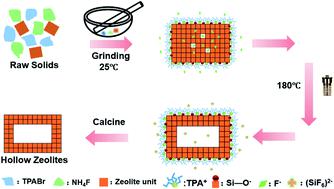Our official English website, www.x-mol.net, welcomes your feedback! (Note: you will need to create a separate account there.)
Protective dissolution: generating secondary pores in zeolite by mechanochemical reaction
RSC Advances ( IF 3.9 ) Pub Date : 2020-4-3 , DOI: 10.1039/d0ra00670j Ju Huang 1 , Yaqi Fan 1 , Guanqun Zhang 1 , Yanhang Ma 1
RSC Advances ( IF 3.9 ) Pub Date : 2020-4-3 , DOI: 10.1039/d0ra00670j Ju Huang 1 , Yaqi Fan 1 , Guanqun Zhang 1 , Yanhang Ma 1
Affiliation

|
Introduction of meso-/macropores into the intrinsic microporous framework of zeolites has raised substantial interest in catalytic reactions with bulky reactants. Herein, we report the formation of secondary meso-/macropores in Silicalite-1 zeolite by a solvent-free mechanochemical grinding process. The strategy allows the preservation of high crystallinity and microporosity of the pristine zeolite, and the generation of mesopores at room temperature and marcopores at higher temperatures. The roles of the tetrapropylammonium bromide (TPABr) and ammonium fluoride (NH4F) have been proposed and demonstrated. A protective layer is formed by TPA+ ions bonded with the surficial defects to shield the outer surface from the direct attack by F−. Instead, F− diffuses into the micropore system in a local aqueous environment within zeolite formed by the mechanochemical reaction. As a result, freely diffused F− selectively dissolves zones with structural defects to form secondary pores inside the zeolite. Moreover, this strategy proves highly effective in encapsulation of nanoparticles (Pt, Co) in the meso-/macropores of Silicalite-1 zeolite, forming a yolk–shell composite catalyst for potential applications.
中文翻译:

保护性溶解:通过机械化学反应在沸石中产生次生孔
将中孔/大孔引入沸石的固有微孔框架中引起了人们对与庞大反应物进行催化反应的极大兴趣。在此,我们报告了通过无溶剂机械化学研磨工艺在 Silicalite-1 沸石中形成次级中孔/大孔。该策略允许保持原始沸石的高结晶度和微孔率,以及在室温下产生中孔和在较高温度下产生大孔。已经提出并证明了四丙基溴化铵 (TPABr) 和氟化铵 (NH 4 F) 的作用。TPA +离子与表面缺陷结合形成保护层,以保护外表面免受 F -的直接攻击。相反,F-在由机械化学反应形成的沸石内的局部水环境中扩散到微孔系统中。结果,自由扩散的F -选择性地溶解具有结构缺陷的区域以在沸石内部形成次生孔。此外,该策略被证明在将纳米颗粒(Pt,Co)封装在 Silicalite-1 沸石的中孔/大孔中非常有效,形成具有潜在应用的蛋黄-壳复合催化剂。
更新日期:2020-04-03
中文翻译:

保护性溶解:通过机械化学反应在沸石中产生次生孔
将中孔/大孔引入沸石的固有微孔框架中引起了人们对与庞大反应物进行催化反应的极大兴趣。在此,我们报告了通过无溶剂机械化学研磨工艺在 Silicalite-1 沸石中形成次级中孔/大孔。该策略允许保持原始沸石的高结晶度和微孔率,以及在室温下产生中孔和在较高温度下产生大孔。已经提出并证明了四丙基溴化铵 (TPABr) 和氟化铵 (NH 4 F) 的作用。TPA +离子与表面缺陷结合形成保护层,以保护外表面免受 F -的直接攻击。相反,F-在由机械化学反应形成的沸石内的局部水环境中扩散到微孔系统中。结果,自由扩散的F -选择性地溶解具有结构缺陷的区域以在沸石内部形成次生孔。此外,该策略被证明在将纳米颗粒(Pt,Co)封装在 Silicalite-1 沸石的中孔/大孔中非常有效,形成具有潜在应用的蛋黄-壳复合催化剂。


























 京公网安备 11010802027423号
京公网安备 11010802027423号